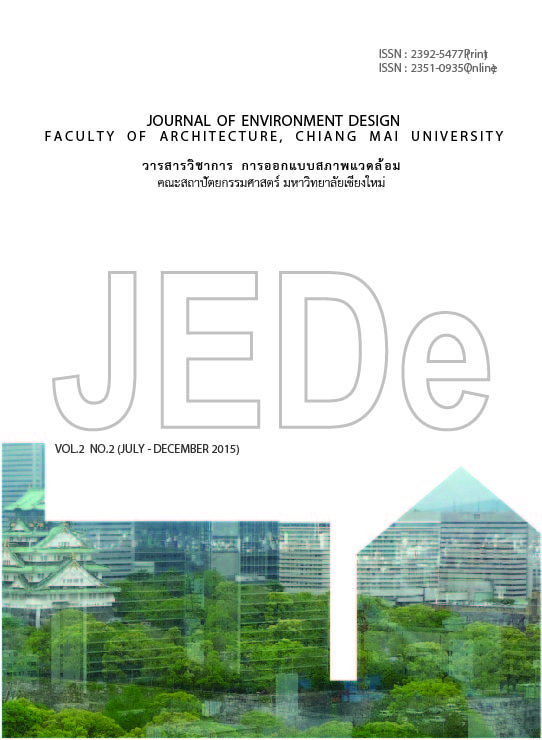Exploring Chiang Mai Architecture in Political Transition Period, between 1884 - 1947
Main Article Content
Abstract
เชียงใหม่เป็นส่วนหนึ่งของกระบวนการการสร้างรัฐสยามสมัยใหม่ บทความชิ้นนี้จึงได้สำรวจงานสถาปัตยกรรมในเชียงใหม่ที่เกิดจากการเปลี่ยนแปลงทางสังคมและการเมือง ในช่วงปลายทศวรรษที่ 19 ซึ่งเป็นช่วงเวลาเดียวกันที่ลัทธิล่าอาณานิคมตะวันตกรุกเข้าสู่ภูมิภาคแถบนี้ แต่ท้ายที่สุดผู้นำของเชียงใหม่จึงเลือกที่จะอยู่ข้างรัฐบาลสยามเพราะปัจจัยทางการเมือง ไม่ใช่เรื่องของชาติพันธุ์แต่อย่างใด เมืองเชียงใหม่กับกรุงเทพก็มีลักษณะทางวิถีชีวิต ภาษา วัฒนธรรมที่ค่อนข้างแตกต่างกันอย่างมาก กรอบความคิดเรื่องการครองอำนาจนำ จึงถูกนำมาใช้ในการศึกษาถึงการเกิดขึ้นของงานสถาปัตยกรรมของหน่วยงานราชการในเมืองเชียงใหม่ที่ถูกกำหนดจากนโยบายของรัฐบาลสยามนั้น ได้สร้างผลกระทบต่อวิถีชีวิต วัฒนธรรม หรือรูปแบบการใช้พื้นที่ทางสังคมอย่างไร ผ่านทั้งมุมมองปัจจัยภายนอกและปัจจัยภายใน ดังนั้นการอธิบาย ตีความ หรือสร้างองค์ความรู้ทางสถาปัตยกรรมจึงกลายเป็นจุดเริ่มต้นในการพยายามสร้างความเข้าใจที่มาที่ไปอันสลับซับซ้อนของงานสถาปัตยกรรมเมืองเชียงใหม่ที่เป็นภาพสะท้อนของความสัมพันธ์ทางสังคมการเมืองระหว่างเชียงใหม่กับรัฐบาลสยามเช่นกัน
Chiang Mai is a part of the process of renewing of the Modern Siam Regime. This paper has explored the architecture in Chiang Mai which has been changed by social and political factors in the late of 19th century Western Colonialism penetrated into the region. However, the leader of Chiang Mai has chosen Siamese government’s side because of political factors. It’s not about the ethnic’s reason at all. Chiang Mai and Bangkok have different languages, cultures and also the life styles. Therefore, the conceptual of Hegemony, which has been used to study the occurrence of the Government’s architecture in Chiang Mai, was determined by Siamese government policy. Is it an impact on life styles, cultures and social spaces through a part of external factors and internal factors As a result, an interpretation of the architecture is the beginning to understand the source of the complexity in Chiang Mai’s architecture because of these things are a reflection between Chiang Mai and Siamese Government which they focused on social and politic part.


